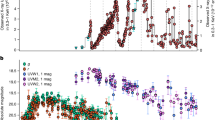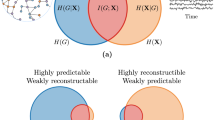Abstract
Simultaneous observations of pulsed radio sources by the 64 m Parkes radio telescope and the Culgoora radioheliograph, 325 km apart, show that most of the amplitude variations in the pulsed signals are imposed at or near the source itself.
This is a preview of subscription content, access via your institution
Access options
Subscribe to this journal
Receive 51 print issues and online access
$199.00 per year
only $3.90 per issue
Buy this article
- Purchase on Springer Link
- Instant access to full article PDF
Prices may be subject to local taxes which are calculated during checkout
Similar content being viewed by others
References
Hewish, A., Bell, S. J., Pilkington, J. D. H., Scott, P. F., and collins, R. A., Nature, 217, 709 (1968).
Radhakrishnan, V., Komesaroff, M. M., and cooke, D. G., Nature, 218, 229 (1968).
Scheuer, P. A. G., Nature, 218, 920 19
Author information
Authors and Affiliations
Rights and permissions
About this article
Cite this article
SLEE, O., KOMESAROFF, M. & McCULLOCH, P. Spaced Receiver Observations of Pulsed Radio Sources. Nature 219, 342–343 (1968). https://doi.org/10.1038/219342a0
Received:
Published:
Issue Date:
DOI: https://doi.org/10.1038/219342a0
This article is cited by
-
Pulsar Amplitude Variations
Nature (1969)
-
Frequency Structure of Pulsar Intensity Variations
Nature (1969)
-
Further Observations of the Crab Nebula Optical Pulsar
Nature (1969)
-
Pulsare, eine neue Klasse radioastronomischer Objekte
Die Naturwissenschaften (1969)
-
Spectral Fine Structure in Pulsar Radiation
Nature (1968)
Comments
By submitting a comment you agree to abide by our Terms and Community Guidelines. If you find something abusive or that does not comply with our terms or guidelines please flag it as inappropriate.



